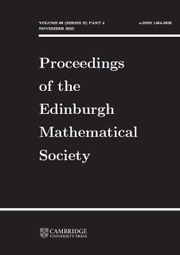Article contents
Bounds for finite semiprimitive permutation groups: order, base size, and minimal degree
Published online by Cambridge University Press: 05 November 2020
Abstract
In this paper, we study finite semiprimitive permutation groups, that is, groups in which each normal subgroup is transitive or semiregular. These groups have recently been investigated in terms of their abstract structure, in a similar way to the O'Nan–Scott Theorem for primitive groups. Our goal here is to explore aspects of such groups which may be useful in place of precise structural information. We give bounds on the order, base size, minimal degree, fixed point ratio, and chief length of an arbitrary finite semiprimitive group in terms of its degree. To establish these bounds, we study the structure of a finite semiprimitive group that induces the alternating or symmetric group on the set of orbits of an intransitive minimal normal subgroup.
MSC classification
Information
- Type
- Research Article
- Information
- Proceedings of the Edinburgh Mathematical Society , Volume 63 , Issue 4 , November 2020 , pp. 1071 - 1091
- Copyright
- Copyright © The Author(s), 2020. Published by Cambridge University Press on Behalf of The Edinburgh Mathematical Society
References
- 2
- Cited by


